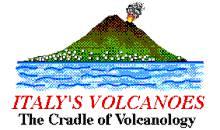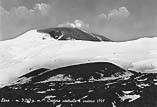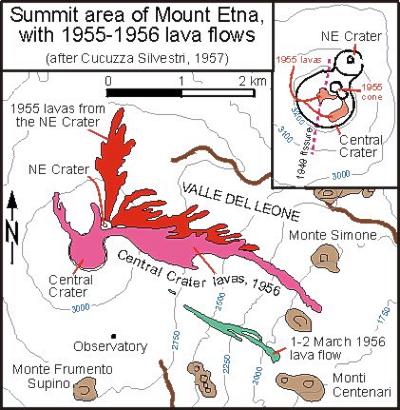| Etna
index |
||
| Geology | Geological history | Cones and craters |
| Eruptive characteristics | Eruptions before 1971 | Eruptions since 1971 |
| Etna and Man | References | Web sites |
| Weather forecasts | FAQ | Latest news |
The
1955-1971 summit eruptions, Part 1
![]()
About 3.5 years after the end of the unusually voluminous flank eruption of 1950-1951 (a typical cycle-closing eruption), the NE Crater started erupting on 5 April 1955. In a manner that was to become typical for this kind of activity, the crater first ejected old fragmental material that had been blocking its conduit, and this was followed by mild Strombolian activity that gradually built a pyroclastic cone and filled much of the former collapse pit at the site of the NE Crater, and on 8 July lava began to spill over the rim of the pit. For the next three months the new cone continued to grow, eventually reaching a height of about 80 m, while a new lava field formed at the N and NE sides of the cone. This activity was interrupted in mid-September by a brief episode of intense eruptive activity from the Voragine within the Central Crater during which a small cone was built within the Voragine and two small lava flows were erupted on the Central Crater floor. The NE Crater activity waned at the end of 1955. No details about the volume of lavas erupted from this crater in 1955 are available, but the lava volume was probably in the range of 106 m3.
Following about two months of quiescence, powerful explosive activity started in the Central Crater on the morning of 28 February 1956. This activity came from several new vents in the S part of the crater, and it gradually increased throughout the day, culminating during the following night with spectacular lava fountains that rose hundreds of meters above the crater. Tephra fell to the SE and ESE, amounting to a thickness of several millimeters in villages on the SE slope and leaving a thin film of fine ash in Catania. The explosive activity was accompanied by lava effusion which first covered the W part of the Central Crater and later produced a lava flow that overflowed the low NE rim of the crater and ran down towards the NE Crater where it ponded before forming a short flow towards NNW. Ash continued to fall to the SE until the evening of 29 February when the continuous activity at the Central Crater became discontinuous, consisting of very strong discrete explosions that continued through the night.
On the early morning of 1 March a new lava flow began to move towards E from the lava pond that had formed at the base of the NE Crater (originating, as noted above, from the lava overflow at the NE rim of the Central Crater); the Central Crater maintained its strong explosive activity throughout the day. Yet another overflow of lava occurred on the NNW rim of the Central Crater during the night of 29 February-1 March, but this resulted only in a very small lava flow with a length of 150 m. The most significant lava flow was that which ran towards E, which eventually reached a length of about 1.5 km.
On the late afternoon of 1 March the explosive activity at the Central Crater reached a new climax, then the eruptive phenomena began to show a distinct diminution, and supply to the lava flows decreased.
At 20:55 h on the same day a new effusive vent became active at an elevation of about 2750 m just below the W rim of the Valle del Bove, and lava began to cascade down the steep slope towards the floor of the Valle del Bove. This effusive activity was not accompanied by any explosive activity at the new vent, presumably because the explosive Central Crater activity of the preceding two days had significantly lowered the gas content within the magma. The beginning of the effusive activity on the W wall of the Valle del Bove was followed within about one hour by a clear reduction of the explosive activity at the Central Crater, while there was still lava overflowing towards the NE Crater. At about 22:30 h, there occurred a brief spasm of violent explosive activity at the Central Crater before the eruptive phenomena ceased altogether in that crater during the following hours, and the overflow of lava ceased.
The last significant event of this complex eruptive episode was the opening of a small fissure about 130-150 m above the effusive vent on the Valle del Bove wall which produced weak explosive activity for several hours before all activity on Etna ended, and the volcano entered into a quiet state that was to last for one month.
Another episode of paroxysmal activity from the Central Crater started on the evening of 2 April 1956. Bad weather prevented observations of the activity for much of the first 30 hours, but it was noted that a new overflow of lava took place on the NE side of the main summit cone, forming a flow that ran towards the NE Crater. On 4 April weather conditions improved and it was possible to observe that again several vents had become active within the Central Crater, and lava was jetting to heights of several hundred meters. Ash falls occurred on the E flank of Etna in a sector encompassing the towns of Zafferana and Giarre.
Lava flows produced by this activity followed the same paths as the lava flows of the preceding eruptive episode of 28 February-2 March, but reached greater lengths than the earlier flows. On the afternoon of 4 April the explosive activity in the Central Crater climaxed with jets of lava up to 400 m high and the uprise of a dense eruption column which drifted E and caused ash falls to as far as the coast. During the evening lava began to flow rapidly around the SE side of the NE Crater and then extended towards the Valle del Leone; at the same time lava began to spill over the NW rim of the Central Crater, and a flow descended for about 700 m in the direction of Punta Lucia.
The next day (5 April), there was a sensible reduction in the intensity of the activity, although the vents within the Central Crater continued to produce powerful explosions. The largest of the new lava flows gradually progressed towards the floor of the Valle del Bove, with its farthest front arriving at an elevation of 2000 m near the old flank craters Monte Simone and Monte Lepre, almost 3 km from the Central Crater. One day later the flow front was at 1900 m elevation, while the Central Crater vents continued to produce explosive activity.
The activity decreased notably early on 7 April, and by about noon
that day the explosive activity in the Central Crater ceased, while
lava continued to flow for several hours thereafter; all activity ended
during the following night.
|
Map of the summit area of Etna showing the distribution of lava flows emplaced during 1955-1956. Most lavas in 1955 erupted from the NE Crater, but minor intracrater flows were emplaced in the Central Crater in that year (see inset at upper right). The eruptive episodes of February-March and April 1956 in the Central Crater produced much more lava, while a small lava flow was erupted on 1-2 March 1956 from a fissure on the upper W wall of the Valle del Bove. |
Cucuzza Silvestri (1957), in his detailed description of the events of 1956, gave unusually precise volume data for the eruptive products of that year: the activity of the Central Crater in February-March produced about 2 x 106 m3 of pyroclastics and 2.4 x 106 m3 of lava, while the minor effusive activity on the W wall of the Valle del Bove produced about 0.17 x 106 m3 of lava. The second eruptive episode at the Central Crater in April ejected another 2 x 106 m3 of pyroclastics and 1.5 x 106 m33 of lava. The total amount of pyroclastics of the 1956 activity is therefore about 4 x 106 m3, while the total volume of lava is around 3.5 x 106 m3.
During the 1956 Central Crater eruptions, several sizeable pyroclastic cones were built in the south-central portion of the crater, the largest of which attained a height of about 70 m above the surrounding crater floor. Its top was at 3290 m elevation, 27 m higher than the summit elevation of Etna before the 1956 activity. The latest significant event of 1956 was the collapse of a new pit in the same location of the Voragine in September of that year.
After about 10 months of quiescence in the summit area of Etna, eruptive activity resumed at the NE Crater on 5 February with the ejection of fragmental material clogging the vent; this was followed by the appearance of fresh magma in the ejections by about 8 or 9 February, and thus a new period of persistent activity was initiated at this crater which was to last, with some interruptions, until May 1958. Most of this activity consisted of typical mild Strombolian bursts. Lava first flowed from a fissure on the E flank of the NE Crater cone on 16 April, forming a small flow to NE; more lava was erupted during the next days, and flows advanced N, NE, E and ESE. Lava effusion occurred at an average rate of about 1 m3 per second. The effusive activity ended on 3 May, followed by a decrease in the Strombolian activity, and after 6 May, the crater emitted only dilute ash.
Volume data given by Cucuzza Silvestri (1958) for the activity of the first half of 1957 amount to a total of 68 x 106 m3 of pyroclastics and 106 m3 of lava. The earlier volume appears highly exaggerated; it is more likely that the volume of pyroclastics did not exceed about 106 m3, while the lava volume may be more correct.
Activity resumed at the NE Crater on 25 August 1957, and until early May 1958 the crater produced the same type of activity as in early 1957. There is very little information available about this period, and the same is true for the next period of persistent activity in November-December 1958 at the NE Crater. It is clear that the activity was Strombolian-effusive, and that lava was extruded at a similar rate as during the early 1957 activity, that is, 1 m3 of lava per second. Due to the scarcity of the available information, volume estimates for that period are close to impossible. Eruptive activity also occurred in March-April 1959, possibly at the Central Crater, without any lava emission. On 17 October 1959 a new long-lived eruption started at the NE Crater that continued until July 1960. Like previous periods of persistent activity this was characterized by discrete Strombolian explosions and slow lava effusion from vents on the flanks or at the base of the pyroclastic cone of the crater which experienced significant growth.
1960-1964: Central Crater and NE Crater eruptions
Copyright © Boris Behncke, "Italy's Volcanoes: The Cradle of Volcanology"


